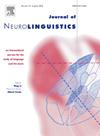儿童和成人的快速自动命名神经网络:与阅读和算术流畅性的联系
IF 1.2
3区 心理学
Q2 LINGUISTICS
引用次数: 0
摘要
快速自动命名(RAN)强调从书面符号到语音信息的快速转换,是阅读和算术熟练程度的可靠预测指标。本研究旨在揭示儿童期至成年期RAN的神经机制,以及其成熟度如何影响阅读和算术能力的发展。利用34名儿童(平均年龄11.82岁,SD = 1.13)和29名成人(平均年龄23.47岁,SD = 2.41)的静息状态功能磁共振成像(fMRI)数据,研究了RAN与内在全脑功能连接体的关系。研究结果显示,儿童以丘脑为中心的RAN网络,而成人则表现出由左皮质区域主导的独特网络。此外,还计算了两个与发展相关的指标:“成人样”网络成熟度,评估每个儿童的RAN网络模式与平均成人网络模式之间的相似程度;“child-unique”网络强度,它测量RAN网络中特定于儿童的连接强度。成人成熟指数与儿童阅读和算术流畅性之间存在显著的正相关,同时阅读和算术网络也存在分离。值得注意的是,一项验证分析证实,这些相关性并不归因于整体的大脑成熟。通过揭示RAN背后的神经机制的具体贡献,本研究为阅读和算术之间发展协方差的神经基础提供了有见地的观点。本文章由计算机程序翻译,如有差异,请以英文原文为准。
Rapid automatized naming neural networks in children and adults: Connections to reading and arithmetic fluency
Emphasizing the rapid transition from written symbols to phonological information, rapid automatized naming (RAN) serves as a robust predictor of proficiency in both reading and arithmetic. The current study aimed to uncover the neural mechanism underlying RAN from childhood to adulthood and how its maturity contributes to the development of reading and arithmetic. Using resting-state functional magnetic resonance imaging (fMRI) data from 34 children (mean age = 11.82 years, SD = 1.13) and 29 adults (mean age = 23.47 years, SD = 2.41), we examined the relationship between RAN and the intrinsic whole-brain functional connectome. The findings revealed a thalamus-centric RAN network in children, whereas adults exhibited a distinct network dominated by left cortical regions. Additionally, two development-related indices were computed: the ‘adult-like’ network maturity, which assesses the degree of similarity between each child's RAN network pattern and the averaged adult network pattern; the ‘child-unique’ network strength, which measures the strength of connections within the RAN network specific to children. Significant positive correlations were observed between the adult-like maturity index and reading and arithmetic fluency in children, alongside the segregation of the reading and arithmetic networks. Notably, a validation analysis confirmed that these correlations were not attributed to the overall brain maturation. By shedding light on the specific contribution of neural mechanisms underlying RAN, this study offers insightful perspectives on the neural underpinnings of the developmental covariance between reading and arithmetic.
求助全文
通过发布文献求助,成功后即可免费获取论文全文。
去求助
来源期刊

Journal of Neurolinguistics
医学-神经科学
CiteScore
3.90
自引率
5.00%
发文量
49
审稿时长
17.2 weeks
期刊介绍:
The Journal of Neurolinguistics is an international forum for the integration of the neurosciences and language sciences. JNL provides for rapid publication of novel, peer-reviewed research into the interaction between language, communication and brain processes. The focus is on rigorous studies of an empirical or theoretical nature and which make an original contribution to our knowledge about the involvement of the nervous system in communication and its breakdowns. Contributions from neurology, communication disorders, linguistics, neuropsychology and cognitive science in general are welcome. Published articles will typically address issues relating some aspect of language or speech function to its neurological substrates with clear theoretical import. Interdisciplinary work on any aspect of the biological foundations of language and its disorders resulting from brain damage is encouraged. Studies of normal subjects, with clear reference to brain functions, are appropriate. Group-studies on well defined samples and case studies with well documented lesion or nervous system dysfunction are acceptable. The journal is open to empirical reports and review articles. Special issues on aspects of the relation between language and the structure and function of the nervous system are also welcome.
 求助内容:
求助内容: 应助结果提醒方式:
应助结果提醒方式:


